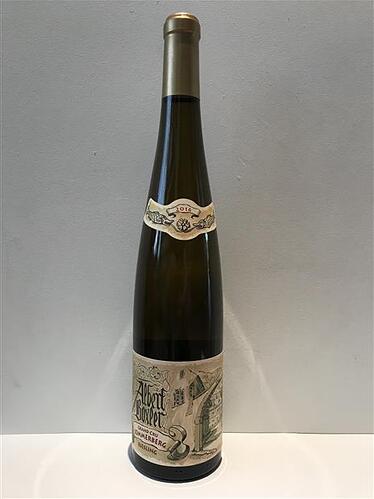Why? Even though many Josmeyer wines are technically dry, they are often so ripe and concentrated they certainly don’t taste dry. Nevertheless, they can make some of the greatest Alsatian Rieslings I know, such as these two:
Intense and concentrated yet also surprisingly youthful lime-green color. Very fruity and quite concentrated nose with bold aromas of peach, some greengage, a little bit of perfumed floral character, light red apple tones, a hint of honeyed richness and a touch of pear jam. The wine is full-bodied, intense and concentrated on the palate with focused flavors of steely minerality, some ripe peach, a little bit of honey and beeswax, light lemony citrus tones, a hint of floral apple blossom and a touch of greengage. The high acidity lends great sense of structure and precision to the wine. The finish is rich, concentrated and quite acid-driven with powerful, complex flavors of ripe lemony citrus fruits, some honeyed richness, a little bit of apple peel bitterness, light white peach tones and a hint of beeswax.
An exceptional GC Riesling with power and concentration that is typical of the style, but outstanding structure and focus to keep the big size of the wine well in check. The wine shows some developed waxiness and richness, but otherwise it is still remarkably youthful in style and most likely the wine will continue to develop for years more. Outstanding and highly recommended. (94 pts.)
Rich and deep golden yellow color. Very juicy, somewhat developed and slightly sweet-toned nose with exceedingly complex aromas of acacia honey, very ripe peach, some dried apricots, a little bit of pineapple, a hint of apple jam and a touch of petrol. By the nose, I’d say this is a dessert wine rather than a dry white. The wine is moderately full-bodied, yet remarkably weightless and delicate on the palate with complex, off-dry flavors of honey, ripe peach, some perfumed floral tones, a little bit of fruit salad syrup, light stony mineral bitterness and a hint of exotic spice. The mouthfeel is broad and somewhat oily and the wine is moderately high in acidity, which is perfectly enough to keep it perfectly balanced. The finish is rich, juicy and suggestive of sweetness with layered flavors of peachy fruit, some spicy wildhoney, a little bit of dried apricots, a hint of bruised apple and a touch of stony mineral bitterness.
A spectacular and wonderfully hedonistic Grand Cru Riesling that shows incredible depth and complexity, but despite its slightly off-dry nature, the wine comes across as remarkably delicate and weightless. Truly a graceful wine. Very highly recommended. (96 pts.)
Posted from CellarTracker
And it was weird finding such a rookie mistake like “2 g/l RS = 2%” in the article. That’s just one order of magnitude off.
